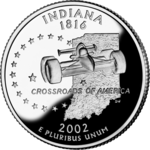Economy of Indiana

Indiana State Quarter
|
|
| Statistics | |
|---|---|
| GDP | $275,676 million |
|
GDP per capita
|
$43,492 |
|
Population below poverty line
|
13.1% |
| 0.434 | |
|
Labor force
|
3,144,700 |
| Unemployment | 3.9% |
| Public finances | |
| Revenues | $13,796.427 million |
| Expenses | $13,036 million |
The total gross state product in 2005 was US$214 billion in 2000 chained dollars. Indiana's per capita income, as of 2005, was US$31,150. A high percentage of Indiana's income is from manufacturing. The Calumet region of northwest Indiana is the largest steel producing area in the U.S. Steelmaking itself requires generating very large amounts of electric power. Indiana's other manufactures include pharmaceuticals and medical devices, automobiles, electrical equipment, transportation equipment, chemical products, rubber, petroleum and coal products, and factory machinery.
Indiana's earliest economy revolved around trade with the Native American tribes in the northern and central parts of the state, which were connected by rivers to the Great Lakes, and ultimately the Atlantic. The state government established a trading monopoly with the tribes who became the primary purchasers of Indiana settler's goods. Although the basis was established in the Northwest Ordinance and well known, economic growth was slow to begin in the state, primarily due to the inability to ship goods to market affordably. After the Mississippi River was opened to American traffic following the Louisiana Purchase, agricultural grew rapidly in the state, but was still hampered by the lack of internal transportation in the state.
The Indiana General Assembly attempted to remedy the transportation system in the late 1810s, but was thwarted by the Panic of 1819 which caused the state's only two banks to collapse. A second attempt was launched in the early 1830s leading to the passage of the Mammoth Internal Improvement Act. This state-funded development of canals, railroads and roads statewide resulted in a large rise in land and produce values, but it too was thwarted by the Panic of 1837; although this spending bankrupted the state, the foundation it provided allowed Indiana to grow into one of the leading farming states by the 1850s.
The 1860s and the American Civil War led to the rapid completion of the state's railroad system and the growth of small industry. Building railroad cars and glass manufacturing became the state early leading industries, established primarily in the central parts of the state. Southern Indiana, however was adversely affected by the war and never regained its economic dominance in the state. Prior to the war, the largest cites were along the Ohio River and had a thriving trade with the south and large ship building centers that languished in the war. In most of the state, the war led to a rise in the value of farm produce and significantly raised the state's standards of living.
...
Wikipedia
